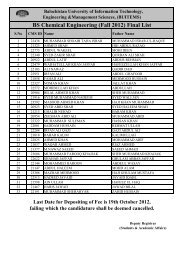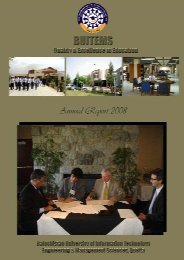BUITEMS
Research Journal - buitems
Research Journal - buitems
- No tags were found...
Create successful ePaper yourself
Turn your PDF publications into a flip-book with our unique Google optimized e-Paper software.
<strong>BUITEMS</strong><br />
Quality & Excellence in Education<br />
Characterization of Sic by Means of C-V Measurement of Respective<br />
Schottky Diode by DLTS<br />
Noor ul Huda Khan Asghar 1* , Zaheer Abbas Gilani 1 , Muhammad Saifullah Awan 2 , Irshad<br />
Ahmad 3 , Wahab Q 4 and Muhammad Asghar 5<br />
1<br />
Department of Physics, Balochistan University of Information Technology, Engineering &<br />
management Sciences, Quetta, 2 Department of Physics, COMSATS Institute of Information<br />
Technology, Islamabad, 3 Govt. Technical Training Institute, Multan-Pakistan, 4 IFM, Linkoping<br />
University, Sweden, 5 Department of Physics, The Islamia University of Bahawalpur<br />
Abstract<br />
Silicon Carbide (SiC) has been characterized by means of capacitance spectroscopy. The<br />
capacitance voltage measurement of respective schottky diode is performed by standard method<br />
available in our DLTS setup. The capacitance voltage measurements of SiC are obtained at<br />
various temperatures under the similar reverse biasing conditions for material. From these<br />
measurements the following parameters were evaluated: The doping concentration of SiC at<br />
room temperature was calculated 5.2061×10 12 cm -3 . Its value increased with increase in<br />
temperature and showed no significant temperature effect. The built-in potential calculated for<br />
SiC at room temperature was 1.49V. Its value gradually decreased with increase in temperature.<br />
The depth profile of SiC became more uniform with increase in temperature and showed no<br />
change as the temperature varied from room temperature to lower values. Comparison of the<br />
data with the literature showed that the sample was affected by native and/or intrinsic point<br />
defects developed during growth or metallization process.<br />
Keywords: Semiconducting Silicon Carbide materials, C-V characteristics, Deep level transient<br />
Spectroscopy of the material, Schottky Diode.<br />
* Corresponding Author’s email: noorulhudakhan@gmail.com<br />
INTRODUCTION<br />
There is significant interest in developing<br />
semiconductor electronic devices capable of<br />
operating over a higher temperature range<br />
and with higher tolerance against ionizing<br />
radiation than currently available. Wide band<br />
gap materials are the potential candidates to<br />
fulfill such requirements and SiC is one of<br />
them. SiC include high-power high-voltage<br />
switching applications, high temperature<br />
electronics, and high power microwave<br />
applications in the 1 - 10 GHz region. SiC is<br />
attractive for these applications because of<br />
its extreme thermal stability, wide band gap<br />
energy, and high breakdown field (Powell<br />
and Rowland, 2002). Because of the wide<br />
band gap energy (3.0 eV and 3.25 eV for the<br />
6H and 4H poly types respectively), leakage<br />
currents in SiC are many orders of<br />
magnitude lower than in silicon. Furthermore,<br />
SiC is the only compound semiconductor<br />
which can be thermally oxidized to form a<br />
high quality native oxide (SiO 2 ). This makes<br />
it possible to fabricate MOSFETs, insulated<br />
gate bipolar transistors (IGBTs), and MOScontrolled<br />
thyristors (MCTs) in SiC (Ikeda,<br />
1988; Hidayet and Enise, 2005).<br />
MATERIALS AND METHODS<br />
Sample preparation<br />
The sample wafer used for this research was<br />
6H-SiC n-type wafer prepared at Linkoping<br />
25
















